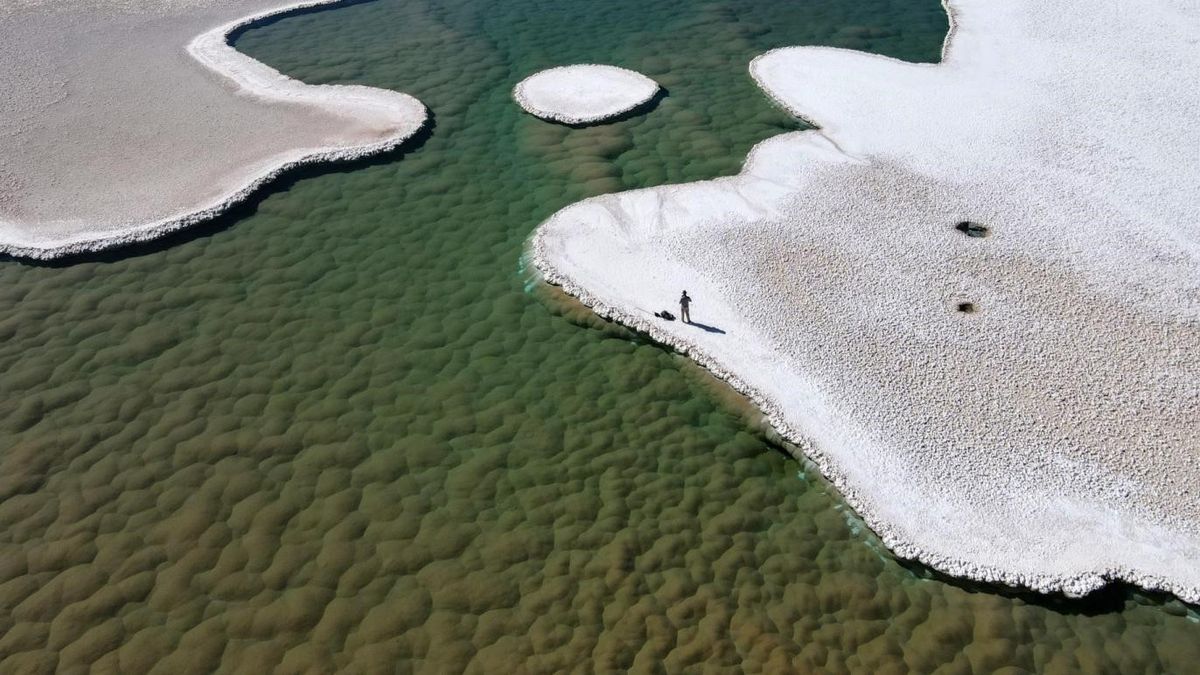Microbes in Atacama desert's lost lagoons may mirror early life on Mars
Researchers have discovered a jaw-dropping ecosystem of crystal-clear lagoons and salt plains in Argentina's Puna de Atacama desert that could offer a window onto early life on Earth and Mars.

A patchwork of crystal-clear lagoons and vast salt plains in Argentina's Puna de Atacama desert forms an otherworldly ecosystem unlike "anything any scientist has ever seen," researchers say.
The never-before-seen lagoons host mounds of rock layered with microbes that, at first glance, resemble some of the first known forms of life on Earth. Researchers discovered this lost world by chance after spotting a network of strange pools on satellite images of the desert in northwestern Argentina.
Puna de Atacama is a giant plateau more than 12,000 feet (3,660 meters) above sea level on the Argentinian border with Chile. There, high altitude, bone-dry conditions and blazing sunshine combine to form a harsh environment where few plants and animals survive.
Related: How the runaway greenhouse gas effect can destroy a planet's habitability — including Earth's
Brian Hynek, an associate professor of geological sciences at the University of Colorado Boulder, and Maria Farías, a microbiologist and co-founder of the environmental consultancy PunaBio, hiked several miles through the barren landscape before they saw the lagoons.
"It's unlike anything I've ever seen or, really, like anything any scientist has ever seen," Hynek said in a statement.
Twelve pools of shallow, crystalline water ringed with mountains make up the newfound alien ecosystem, which stretches across 25 acres (10 hectares) of desert, according to the statement. Beneath the lagoons' surface, the researchers spied small hills carpeted with green microbial growth.
Breaking space news, the latest updates on rocket launches, skywatching events and more!
"It's just amazing that you can still find undocumented things like that on our planet," Hynek said, adding that the discovery constitutes "the biggest eureka moment I've ever had in my life."
The living mounds, which measured some 15 feet (4.6 m) across and several feet high, offer a window into the earliest stage of life on Earth and potentially even ancient life on Mars, Hynek said. Preliminary observations indicate they could be stromatolites — complex communities of microbes whose excretions solidify into layers of rock — similar to those that existed during a period of Earth's history called the Archaean (4 billion to 2.5 billion years ago), when the atmosphere contained no oxygen.
Stromatolites still form today in various marine and freshwater habitats, but they grow much smaller than their ancient counterparts. The mounds in the Atacama lagoons were close in size to Archaean stromatolites, which fossil discoveries indicate grew up to 20 feet (6 m) high. The Atacama stromatolites were mostly made of gypsum — a mineral common in fossilized stromatolites, but absent from modern examples.

"We think these mounds are actually growing from the microbes, which is what was happening in the oldest ones," Hynek said.
The hilly formations — soaked in the lagoons' salty, acidic waters and baked by extreme solar radiation — hosted two types of microbes, with layers of photosynthetic bacteria called cyanobacteria coating the outside, and communities of single-celled organisms known as archaea thriving at the core.
"If life ever evolved on Mars to the level of fossils, it would have been like this," Hynek said. "Understanding these modern communities on Earth could inform us about what we should look for as we search for similar features in the Martian rocks."
But researchers will have to act fast if they want to confirm these initial observations, as the site has been leased to mine for lithium.
"This entire, unique ecosystem could be gone in a matter of years," Hynek said. "We're hoping that we can protect some of these sites, or at least detail what's there before it's gone or disturbed forever."

Sascha is a U.K.-based trainee staff writer at Live Science. She holds a bachelor’s degree in biology from the University of Southampton in England and a master’s degree in science communication from Imperial College London. Her work has appeared in The Guardian and the health website Zoe. Besides writing, she enjoys playing tennis, bread-making and browsing second-hand shops for hidden gems.

